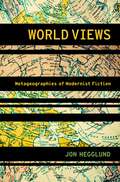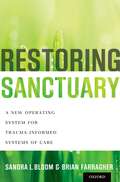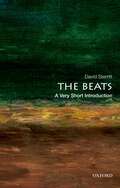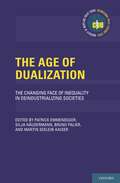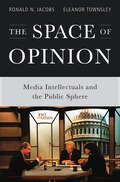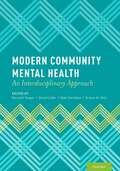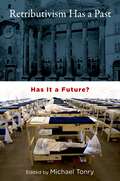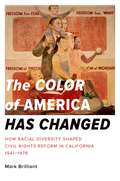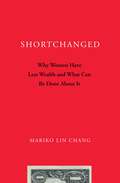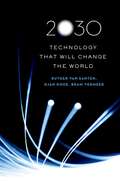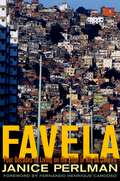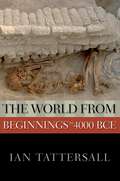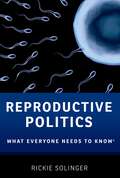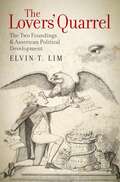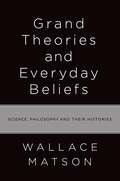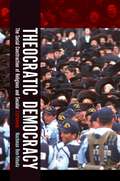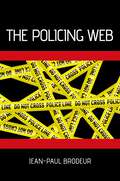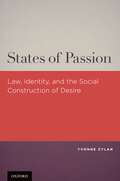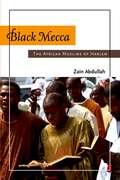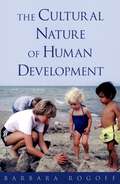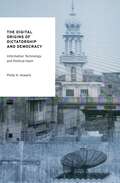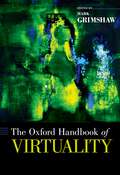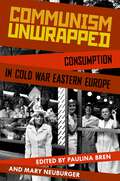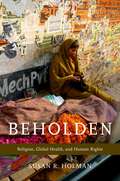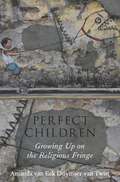- Table View
- List View
World Views: Metageographies of Modernist Fiction (Modernist Literature and Culture)
by Jon HegglundWorld Views examines literary representations of spatial form within the contexts of the emerging disciplines of geography, geopolitics, and international relations, positing that modernism's experimental engagements with space intended to imagine alternatives to the new world order.
Restoring Sanctuary: A New Operating System for Trauma-Informed Systems of Care
by Sandra L. Bloom Brian FarragherThis is the third in a trilogy of books that chronicle the revolutionary changes in our mental health and human service delivery systems that have conspired to disempower staff and hinder client recovery. Creating Sanctuary documented the evolution of The Sanctuary Model therapeutic approach as an antidote to the personal and social trauma that clients bring to child welfare agencies, psychiatric hospitals, and residential facilities. Destroying Sanctuary details the destructive role of organizational trauma in the nation's systems of care. Restoring Sanctuary is a user-friendly manual for organizational change that addresses the deep roots of toxic stress and illustrates how to transform a dysfunctional human service system into a safe, secure, trauma-informed environment. At its heart, The Sanctuary Model represents an organizational value system that is committed to seven principles, which serve as anchors for decision making at all levels: non-violence, emotional intelligence, social learning, democracy, open communication, social responsibility, and growth and change. The Sanctuary Model is not a clinical intervention; rather, it is a method for creating an organizational culture that can more effectively provide a cohesive context within which healing from psychological and socially derived forms of traumatic experience can be addressed. Chapters are organized around the seven Sanctuary commitments, providing step-by-step, realistic guidance on creating and sustaining fundamental change. "Restoring Sanctuary" is a roadmap to recovery for our nation's systems of care. It explores the notion that organizations are living systems themselves and as such they manifest various degrees of health and dysfunction, analogous to those of individuals. Becoming a truly trauma-informed system therefore requires a process of reconstitution within helping organizations, top to bottom. A system cannot be truly trauma-informed unless the system can create and sustain a process of understanding itself.
The Beats: A Very Short Introduction (Very Short Introductions)
by David SterrittIn the late 1950s and early 1960s, the writers of the Beat Generation revolutionized American literature with their iconoclastic approach to language and their angry assault on the conformity and conservatism of postwar society. They and their followers took aim at the hypocrisy and taboos of their time--particularly those involving sex, race, and class--in such provocative works as Jack Kerouac's On the Road (1957), Allen Ginsberg's "Howl" (1956), and William S. Burroughs's Naked Lunch (1959). In this Very Short Introduction, David Sterritt offers a concise overview of the social, cultural, and aesthetic sensibilities of the Beats, bringing out the similarities that connected them and also the many differences that made them a loosely knit collective rather than an organized movement. Figures in the saga include Neal Cassady, Gregory Corso, Lawrence Ferlinghetti, John Clellon Holmes, Carolyn Cassady, and Gary Snyder. As Sterritt ranges from Greenwich Village and San Francisco to Mexico, western Europe, and North Africa, he sheds much light on how the Beats approached literature, drugs, sexuality, art, music, and religion. Members of the Beat Generation hoped that their radical rejection of materialism, consumerism, and regimentation would inspire others to purify their lives and souls as well. Yet they urged the remaking of consciousness on a profoundly inward-looking basis, cultivating "the unspeakable visions of the individual," in Kerouac's phrase. The idea was to revolutionize society by revolutionizing thought, not the other way around. This book explains how the Beats used their antiauthoritarian visions and radical styles to challenge dominant values, fending off absorption into mainstream culture while preparing ground for the larger, more explosive social upheavals of the 1960s. More than half a century later, the Beats' impact can still be felt in literature, cinema, music, theater, and the visual arts. This compact introduction explains why. About the Series: Oxford's Very Short Introductions series offers concise and original introductions to a wide range of subjects--from Islam to Sociology, Politics to Classics, Literary Theory to History, and Archaeology to the Bible. Not simply a textbook of definitions, each volume in this series provides trenchant and provocative--yet always balanced and complete--discussions of the central issues in a given discipline or field. Every Very Short Introduction gives a readable evolution of the subject in question, demonstrating how the subject has developed and how it has influenced society. Eventually, the series will encompass every major academic discipline, offering all students an accessible and abundant reference library. Whatever the area of study that one deems important or appealing, whatever the topic that fascinates the general reader, the Very Short Introductions series has a handy and affordable guide that will likely prove indispensable.
The Age of Dualization: The Changing Face of Inequality in Deindustrializing Societies (International Policy Exchange)
by Patrick Emmenegger Silja Häusermann Bruno Palier Martin Seeleib-KaiserPoverty, increased inequality, and social exclusion are back on the political agenda, not only as a consequence of the Great Recession of 2008, but also because of a seemingly structural trend towards increased inequality in advanced industrial societies that has persisted since the 1970s. Policies in labor markets, social policy, and political representation are strongly linked in the creation, widening, and deepening of insider-outsider divides--a process known as dualization. While it is certainly not the only driver of increasing inequality, its development across multiple domains makes dualization one of the most important current trends affecting developed societies. The comparative perspective of this book provides insights into why Nordic countries witness lower levels of insider-outsider divides, whereas in continental, liberal and southern welfare states, they are more likely to constitute a core characteristic of the political economy. Most importantly, the comparisons presented in this book point to the crucial importance of politics and political choice in driving and shaping the social outcomes of deindustrialization. While increased structural labor market divides can be found across all countries, governments have a strong responsibility in shaping the distributive consequences of these labor market changes. Insider-outsider divides are ultimately the result of political choice. A landmark publication, this volume is geared for faculty and graduate students of economics, political science, social policy, and sociology, as well as policymakers concerned with increasing inequality in a period of deep economic and social crisis.
The Space of Opinion: Media Intellectuals and the Public Sphere
by Ronald N. Jacobs Eleanor TownsleyWhile the newspaper op-ed page, the Sunday morning political talk shows on television, and the evening cable-news television lineup have an obvious and growing influence in American politics and political communication, social scientists and media scholars tend to be broadly critical of the rise of organized punditry during the 20th century without ever providing a close empirical analysis. What is the nature of the contemporary space of opinion? How has it developed historically? What kinds of people speak in this space? What styles of writing and speech do they use? What types of authority and expertise do they draw on? And what impact do their commentaries have on public debate? To describe and analyze this complex space of news media, Ronald Jacobs and Eleanor Townsley rely on enormous samples of opinion collected from newspapers and television shows during the first years of the last two Presidential administrations. They also employ biographical data on authors of opinion to connect specific argument styles to specific types of authors, and examine the distribution of authors and argument types across different formats. The result is a close mapping that reveals a massive expansion and differentiation of the opinion space. It tells a complex story of shifting intersections between journalism, politics, the academy, and the new sector of think tanks. It also reveals a proliferation of genres and forms of opinion; not only have the people who speak within the space of opinion become more diverse over time, but the formats of opinion-claims to authority, styles of speech, and modes of addressing publics-have also become more varied. Though Jacobs and Townsley find many changes, they also find continuities. Despite public anxieties, the project of objective journalism is alive and well, thriving in the older, more traditional formats, and if anything, the proliferation of newer formats has resulted in an intensified commitment (by some) to core journalistic values as clear points of difference that offer competing logics of distinction and professional justification. But the current moment does represent a real challenge as more and different shows compete to narrate politics in the most compelling, authoritative, and influential manner. By providing the first systematic study of media opinion and news commentary, The Space of Opinion will fill an important gap on research about media, politics, and the civil society and will attract readers in a number of disciplines, including sociology, communication, media studies, and political science.
Modern Community Mental Health: An Interdisciplinary Approach
by Kenneth Yeager David Cutler Dale Svendsen Grayce M. SillsLandmark events, such as the 50th anniversary of the Eisenhower Commission Report and the same anniversary of the Community Mental Health Act, helped launch the community mental health movement. The Rehabilitation Act of 1973 and the President's New Freedom Commission have continued this work by establishing funding sources and highlighting the importance of recovery and excellence in care. Modern Community Mental Health: An Interdisciplinary Approach integrates each of the key concepts contained within the presidential reports and landmark legislation into the context of today's community service delivery system. This pathfinding textbook promises to revolutionize community mental health training by responding to the realities of modern health care delivery systems, presenting an integrated, interdisciplinary paradigm of care. Extraordinarily broad in coverage, it will open a door of possibilities to those caring for the mentally ill in the community. Recognizing that community-based services must be truly collaborative in order to be effective and efficient, the editors have assembled a cast of contributors from among the brightest lights in community practice. Chapter authors, who are currently doing interdisciplinary work successfully on a daily basis, will collaborate on writing teams to offer their insight into the problems and triumphs that are part of this approach. They will cover not only macro issues such as the economics of behavioral healthcare, reimbursement models, and quality improvement, but the specific skills necessary for competent practice such as treatment planning, clinical documentation, risk management, and partnering with members of a team that may include social workers, psychiatrists, psychologists, and nurses. Twenty additional chapters will provide detailed roadmaps to practices and programs that have been shown to be effective when delivered in a community setting--such as supported employment, assertive community treatment (ACT) teams, crisis intervention training (CIT), family psychoeducation, and supported housing--and will be grounded in educational benchmarks, healthcare reform opportunities, and cultural competencies. By definition community mental health practice is never static. As communities change, the profession changes, and in recent years changes in funding have drastically impacted the system of care. We need empirically supported interventions, to include the voice of the consumers and their families, and have a way to educate current and future professionals so that we all truly work together.
Retributivism Has a Past: Has It a Future? (Studies in Penal Theory and Philosophy)
by Michael TonryFor nearly two centuries in the United States, the punishment of crime was largely aimed, in theory and in practice, at prevention, rehabilitation or incapacitation, and deterrence. In the mid-1970s, a sharp-and some argued permanent-shift occurred. Punishment in the criminal justice system became first and foremost about retribution. Retribution trumped rehabilitation; proportionality outweighed prevention. The retributivist sea change was short-lived, however. After a few decades, some policy makers returned tentatively to individualized approaches to punishment, launching initiatives like drug courts and programs for treatment and reentry. Others promoted policies that retained the rhetoric but betrayed the theory-punishment in proportion to culpability-of retributivism, resulting in mandatory minimum sentences, three-strikes-and-you're-out laws, "dangerous offender" and "sexual predator" laws, "truth in sentencing," and life without the possibility of parole. What now for retributivism? Retributivism Has a Past: Has It a Future? brings thoughtfulness and rigor back into the retributivism debate. This collection of essays trains some of the most influential and brightest established and up-and-coming legal and philosophical minds on how retributivism does, might, or should affect contemporary policy and practices. The volume's aim is neither to condemn nor to justify, but to take new policies and practices seriously and examine them closely. At a time when criminal-justice policy makers are forced to reconsider contemporary approaches to punishment and attempt to devise new ones, Retributivism Has a Past: Has It a Future? offers serious theoretical critiques of the recent past and justifications for possible futures.
The Color of America Has Changed: How Racial Diversity Shaped Civil Rights Reform in California, 1941-1978
by Mark BrilliantFrom the moment that the attack on the "problem of the color line," as W.E.B. DuBois famously characterized the problem of the twentieth century, began to gather momentum nationally during World War II, California demonstrated that the problem was one of color lines. In The Color of America Has Changed, Mark Brilliant examines California's history to illustrate how the civil rights era was a truly nationwide and multiracial phenomenon-one that was shaped and complicated by the presence of not only blacks and whites, but also Mexican Americans, Japanese Americans, and Chinese Americans, among others. Focusing on a wide range of legal and legislative initiatives pursued by a diverse group of reformers, Brilliant analyzes the cases that dismantled the state's multiracial system of legalized segregation in the 1940s and subsequent battles over fair employment practices, old-age pensions for long-term resident non-citizens, fair housing, agricultural labor, school desegregation, and bilingual education. He concludes with the conundrum created by the multiracial affirmative action program at issue in the United States Supreme Court's 1978 Regents of the University of California v. Bakke decision. The Golden State's status as a civil rights vanguard for the nation owes in part to the numerous civil rights precedents set there and to the disparate challenges of civil rights reform in multiracial places. While civil rights historians have long set their sights on the South and recently have turned their attention to the North, advancing a "long civil rights movement" interpretation, Mark Brilliant calls for a new understanding of civil rights history that more fully reflects the racial diversity of America.
Shortchanged: Why Women Have Less Wealth and What Can Be Done About It
by Mariko Lin ChangWomen now receive more college degrees than men, and enter the workforce with better job opportunities than ever before. Indeed, the wage gap between men and women has never been smaller. So why does the typical woman have only 36 cents for every dollar of wealth owned by the typical man? How is it that never-married women working full-time have only 16% as much wealth as similarly situated men? And why do single mothers have only 8% of the wealth of single fathers? The first book to focus on the differences in wealth between women and men, Shortchanged is a compelling and accessible examination of why women struggle to accumulate assets, who has what, and why it matters. Mariko Lin Chang draws on the most comprehensive national data on wealth and on in-depth interviews to show how differences in earnings, in saving and investing, and, most important, the demands of care-giving all contribute to the gender-wealth gap. She argues that the current focus on equal pay and family-friendly workplace policies, although important, will not ultimately change or eliminate wealth inequalities. What Chang calls the "wealth escalator"--comprised of fringe benefits, the tax code, and government benefits--and the "debt anchor" must be the targets of policies aimed at strengthening women's financial resources. Chang proposes a number of practical suggestions to address the unequal burdens and consequences of care-giving, so that women who work just as hard as men will not be left standing in financial quicksand. A comprehensive portrait of where women and men stand with respect to wealth, Shortchanged not only sheds light on why women lack wealth, but also offers solutions for improving the financial situation of women, men, and families.
2030: Technology That Will Change the World
by Rutger van Santen Djan Khoe Bram VermeerImagine living in 1958, and knowing that the integrated circuit--the microchip--was about to be invented, and would revolutionize the world. Or imagine 1992, when the Internet was about to transform virtually every aspect of our lives. Incredibly, this book argues that we stand at such a moment right now--and not just in one field, but in many. In 2030, authors Rutger van Santen, Djan Khoe, and Bram Vermeer interview over two dozen scientific and technological experts on themes of health, sustainability and communication, asking them to look forward to the year 2030 and comment on the kind of research that will play a necessary role. If we know what technology will be imperative in 2030, the authors reason, what can we do now to influence future breakthroughs? Despite working in dissimilar fields, the experts called upon in the book - including Hans Blix (Head of the UN investigation in Iraq), Craig Venter (explorer of the human DNA), and Susan Greenfield (a leading world authority on the human brain), among many others - all emphasize the interconnectedness of our global networks in technology and communication, so tightly knit that the world's major conflicts are never isolated incidents. A fresh understanding of the regularities underlying these complex systems is more important than ever. Using bright, accessible language to discuss topics of universal interest and relevance, 2030 takes the position that we can, in fact, influence the course of history. It offers a new way of looking forward, a fresh perspective on sustainability, stability and crisis-prevention. For anyone interested in modern science, this book will showcase the technologies that will soon change the way we live.
Favela: Four Decades of Living on the Edge in Rio de Janeiro
by Janice PerlmanJanice Perlman wrote the first in-depth account of life in the favelas, a book hailed as one of the most important works in global urban studies in the last 30 years. Now, in Favela, Perlman carries that story forward to the present. Re-interviewing many longtime favela residents whom she had first met in 1969--as well as their children and grandchildren--Perlman offers the only long-term perspective available on the favelados as they struggle for a better life. Perlman discovers that while educational levels have risen, democracy has replaced dictatorship, and material conditions have improved, many residents feel more marginalized than ever. The greatest change is the explosion of drug and arms trade and the high incidence of fatal violence that has resulted. Yet the greatest challenge of all is job creation--decent work for decent pay. If unemployment and under-paid employment are not addressed, she argues, all other efforts will fail to resolve the fundamental issues. Foreign Affairs praises Perlman for writing "with compassion, artistry, and intelligence, using stirring personal stories to illustrate larger points substantiated with statistical analysis."
The World from Beginnings to 4000 BCE (New Oxford World History)
by Ian TattersallTo be human is to be curious. And one of the things we are most curious about is how we came to be who we are--how we evolved over millions of years to become creatures capable of inquiring into our own evolution. In this lively and readable introduction, renowned anthropologist Ian Tattersall thoroughly examines both fossil and archaeological records to trace human evolution from the earliest beginnings of our zoological family, Hominidae, through the appearance of Homo sapiens to the Agricultural Revolution. He begins with an accessible overview of evolutionary theory and then explores the major turning points in human evolution: the emergence of the genus Homo, the advantages of bipedalism, the birth of the big brain and symbolic thinking, Paleolithic and Neolithic tool making, and finally the enormously consequential shift from hunter-gatherer to agricultural societies 10,000 years ago. Focusing particularly on the pattern of events and innovations in human biological and cultural evolution, Tattersall offers illuminating commentary on a wide range of topics, including the earliest known artistic expressions, ancient burial rites, the beginnings of language, the likely causes of Neanderthal extinction, the relationship between agriculture and Christianity, and the still unsolved mysteries of human consciousness. Complemented by a wealth of illustrations and written with the grace and accessibility for which Tattersall is widely admire, The World from Beginnings to 4000 BCE invites us to take a closer look at the strange and distant beings who, over the course of millions of years, would become us.
Reproductive Politics: What Everyone Needs to Know® (What Everyone Needs To Know®)
by Rickie SolingerThe term "reproductive politics" was coined by feminists in the 1970s to describe contemporary Roe v. Wade-era power struggles over contraception and abortion, adoption and surrogacy, and other satellite issues. Forty years later, questions about reproductive rights are just as complex--and controversial--as they were then. Focusing mainly on the United States, Reproductive Politics: What Everyone Needs to Know® explores the legal, political, religious, social, ethical, and medical dimensions of this hotly contested arena. Tracing the historical roots of reproductive politics up through the present, Rickie Solinger considers a range of topics from abortion and contraception to health care reform and assisted reproductive technologies. Solinger tackles some of the most contentious questions up for debate today, including the definition of "fetal personhood," and the roles poverty and welfare policy play in shaping reproductive rights. The answers she provides are informative, balanced, and sometimes quite surprising. Offering a wide range of information in an accessible and engaging manner, Reproductive Politics: What Everyone Needs to Know® orients readers and provides the knowledge necessary to follow the debates in this important and continually evolving field. What Everyone Needs to Know® is a registered trademark of Oxford University Press.
The Lovers' Quarrel: The Two Foundings and American Political Development
by Elvin T. LimThe United States has had not one, but two Foundings. The Constitution produced by the Second Founding came to be only after a vociferous battle between Federalists and Anti-Federalists. The Federalists favored a relatively powerful central government, while the Anti-Federalists distrusted the concentration of power in one place and advocated the preservation of sovereignty in the states as crucibles of post-revolutionary republicanism -- the legacy of the First Founding. This philosophical cleavage has been at the heart of practically every major political conflict in U.S. history, and lives on today in debates between modern liberals and conservatives. In The Lovers' Quarrel, Elvin T. Lim presents a systematic and innovative analysis of this perennial struggle. The framers of the second Constitution, the Federalists, were not operating in an ideational or institutional vacuum; rather, the document they drafted and ratified was designed to remedy the perceived flaws of the Articles of Confederation and Perpetual Union. To decouple the Two Foundings is to appreciate that there is no such thing as "original meaning," only original dissent. Because the Anti-Federalists insisted that prior and democratically sanctioned understandings of federalism and union had to be negotiated and partially grafted onto the new Constitution, the Constitution's Articles and the Bill of Rights do not cohere as well together as has conventionally been thought. Rather, they represent two antithetical orientations toward power, liberty, and republicanism. The altercation over the necessity of the Second Founding generated coherent and self-contained philosophies that would become the core of American political thought, reproduced and transmitted across two centuries, whether the victors were the neo-Federalists (such as during the Civil War and the New Deal) or the neo-Anti-Federalists (such as during the Jacksonian era and the Reagan Revolution). The Second Founding -- the sole "founding" that we generally speak of -- would become a template for the unique, prototypically American species of politics and political debate. Because of it, American political development occurs only after the political entrepreneurs of each generation lock horns in a Lovers' Quarrel about the principles of one of the Two Foundings, and succeed in justifying and forging a durable expansion or contraction of federal authority.
Grand Theories and Everyday Beliefs: Science, Philosophy, and their Histories
by Wallace MatsonThis unconventional book by a distinguished historian of philosophy tells the story of how humans became rational beings.
Theocratic Democracy: The Social Construction of Religious and Secular Extremism
by Nachman Ben-YehudaThe state of Israel was established in 1948 as a Jewish democracy, without a legal separation between religion and the state. Ever since, the tension between the two has been a central political, social, and moral issue in Israel, resulting in a cultural conflict between secular Jews and the fundamentalist, ultra-orthodox Haredi community. What is the nature of this cultural conflict and how is it managed? In Theocratic Democracy, Nachman Ben-Yehuda examines more than fifty years of media-reported unconventional and deviant behavior by members of the Haredi community. Ben-Yehuda finds not only that this behavior has happened increasingly often over the years, but also that its most salient feature is violence--a violence not random or precipitated by situational emotional rage, but planned and aimed to achieve political goals. Using verbal and non-verbal violence in the forms of curses, intimidation, threats, arson, stone-throwing, beatings, mass violations, and more, Haredi activists try to push Israel toward a more theocratic society. Driven by a theological notion that all Jews are mutually responsible and accountable to the Almighty, these activists believe that the sins of the few are paid for by the many. Making Israel a theocracy will, they believe, reduce the risk of transcendental penalties. Ben-Yehuda shows how the political structure that accommodates the strong theocratic and secular pressures Israel faces is effectively a theocratic democracy. Characterized by chronic negotiations, tensions, and accommodations, it is by nature an unstable structure. However, in his fascinating and lively account, Nachman Ben-Yehuda demonstrates how it allows citizens with different worldviews to live under one umbrella of a nation-state without tearing the social fabric apart.
The Policing Web (Studies in Crime and Public Policy)
by Jean-Paul BrodeurNearly all research devoted to policing focuses on public uniformed police and their legal use of force. An overwhelming amount of this work draws on evidence from Anglo-American police forces. These twin emphases have led to a limited view. Agencies such as criminal investigation units, intelligence services, private security companies, and military policing organizations have almost entirely escaped scholarly attention. In The Policing Web, Jean-Paul Brodeur looks at policing as a whole. He illuminates its full diversity, showing how it extends far beyond the confines of public police working in uniform and visible to all. Brodeur considers military policing, both when it complements the values of democracy and when it does not. He also discusses criminal individuals acting as police informants, and criminal organizations enforcing their own rules in urban zones deserted by the police. Brodeur argues that the diverse strands of the policing web are united by a common definition that emphasizes the license granted to policing agencies-legally or with impunity- to use means otherwise forbidden to the rest of the population. Employing an international and comparative approach, Brodeur establishes a comprehensive model that links all the components of policing. The policing web, however, is not a neat and well-integrated structure. There is not just one policing web. There are several, depending on the country, police history and culture, and the various public images of policing. These often overlooked factors are essential components of the context of policing. Wide-ranging and authoritative, The Policing Web expands the very idea of what policing is and how it works, and presents a novel yet fundamental understanding of law enforcement.
States of Passion: Law, Identity, and Social Construction of Desire
by Yvonne ZylanIn States of Passion: Law, Identity and the Social Construction of Desire, Professor Yvonne Zylan explores the role of legal discourse in shaping sexual experience, sexual expression, and sexual identity. The book focuses on three topics: anti-gay hate crime laws, same-sex sexual harassment, and same-sex marriage, examining how sexuality is socially constructed through the institutionally-specific production of legal discourse. States of Passion argues that law's power to authorize specific discourses and practices of love, desire, hatred, fear, and vulnerability remain grounded in the powerful discourses and institutional practices that mark law as dispassionate, cerebral, and fundamentally procedural. States of Passion contends that those states of passion we experience in our daily lives as particularly significant-to our sense of self, to our collective and social identities, and to our ideas about the body and its dictates-increasingly have as much to do with the state as they do with passion.
Black Mecca: The African Muslims of Harlem
by Zain AbdullahThe changes to U.S. immigration law that were instituted in 1965 have led to an influx of West African immigrants to New York, creating an enclave Harlem residents now call ''Little Africa.'' These immigrants are immediately recognizable as African in their wide-sleeved robes and tasseled hats, but most native-born members of the community are unaware of the crucial role Islam plays in immigrants' lives. Zain Abdullah takes us inside the lives of these new immigrants and shows how they deal with being a double minority in a country where both blacks and Muslims are stigmatized. Dealing with this dual identity, Abdullah discovers, is extraordinarily complex. Some longtime residents embrace these immigrants and see their arrival as an opportunity to reclaim their African heritage, while others see the immigrants as scornful invaders. In turn, African immigrants often take a particularly harsh view of their new neighbors, buying into the worst stereotypes about American-born blacks being lazy and incorrigible. And while there has long been a large Muslim presence in Harlem, and residents often see Islam as a force for social good, African-born Muslims see their Islamic identity disregarded by most of their neighbors. Abdullah weaves together the stories of these African Muslims to paint a fascinating portrait of a community's efforts to carve out space for itself in a new country.
The Cultural Nature of Human Development
by Barbara RogoffThree-year-old Kwara'ae children in Oceania act as caregivers of their younger siblings, but in the UK, it is an offense to leave a child under age 14 ears without adult supervision. In the Efe community in Zaire, infants routinely use machetes with safety and some skill, although U.S. middle-class adults often do not trust young children with knives. What explains these marked differences in the capabilities of these children? Until recently, traditional understandings of human development held that a child's development is universal and that children have characteristics and skills that develop independently of cultural processes. Barbara Rogoff argues, however, that human development must be understood as a cultural process, not simply a biological or psychological one. Individuals develop as members of a community, and their development can only be fully understood by examining the practices and circumstances of their communities.
The Digital Origins of Dictatorship and Democracy: Information Technology and Political Islam (Oxford Studies in Digital Politics)
by Philip N. HowardAround the developing world, political leaders face a dilemma: the very information and communication technologies that boost economic fortunes also undermine power structures. Globally, one in ten internet users is a Muslim living in a populous Muslim community. In these countries, young people are developing political identities online, and digital technologies are helping civil society build systems of political communication independent of the state and beyond easy manipulation by cultural or religious elites. With unique data on patterns of media ownership and technology use, The Digital Origins of Dictatorship and Democracy demonstrates how, since the mid-1990s, information technologies have had a role in political transformation. Democratic revolutions are not caused by new information technologies. But in the Muslim world, democratization is no longer possible without them.
The Oxford Handbook of Virtuality (Oxford Handbooks)
by Mark GrimshawAs this comprehensive and multidisciplinary book makes clear, virtuality has a pedigree that pre-dates the computer age and modern virtual worlds, a pedigree that can be traced back to classical mythology and beyond. Equally, the concept of virtuality is not the province of one field of study alone but is the foundation and driving force of many, both theoretical and applied. Our conceptualizations and applications of virtuality are multiple, as contributors demonstrate across the nine sections of the book that move from philosophy to technologies and applications before returning to philosophy again for a discussion of the utopias and dystopias of virtuality. The almost 50 essays contained within range freely across subjects that include the potential of virtuality, ethics, virtuality and self, presence and immersion, virtual emotions, image, sound and literature, computer games, AI and A-Life, Augmented Reality and Real Virtuality, law and economics, medical and military applications, religion, and cybersex. Throughout, contributors discuss differences between virtuality, reality, and actuality, in debates filtered through the lenses of the disciplines represented here, and speculate on future directions. It is not at all clear that there are differences and, if such distinctions are to be found, the boundaries between virtuality, reality, and actuality continually shift as ideas, modes of organization, and behaviors constantly flow from one to the other regardless of direction. The Handbook presents no unified definition of virtuality to comfort the reader, rather a multiplicity of questions and approaches underpinned by provocative statements that should further fuel the debates surrounding our notions of virtuality.
Communism Unwrapped: Consumption in Cold War Eastern Europe
by Paulina Bren Mary NeuburgerCommunism Unwrapped reveals the complex world of consumption in Cold War Eastern Europe, exploring the ways people shopped, ate, drank, smoked, cooked, acquired, assessed and exchanged goods. These everyday experiences, the editors and contributors argue, were central to the way that communism was lived in its widely varied contexts in the region. From design, to production, to retail sales and black market exchange, Communism Unwrapped follows communist goods from producer to consumer, tracing their circuitous routes. In the communist world this journey was rife with its own meanings, shaped by the special political and social circumstances of these societies. In examining consumption behind the Iron Curtain, this volume brings dimension and nuance to understandings of the communist period and the history of consumerism.
Beholden: Religion, Global Health, and Human Rights
by Susan R. HolmanWinner of the 2016 Grawemeyer Award in Religion Global health efforts today are usually shaped by two very different ideological approaches: a human rights-based approach to health and equity-often associated with public health, medicine, or economic development activities; or a religious or humanitarian "aid" approach motivated by personal beliefs about charity, philanthropy, missional dynamics, and humanitarian "mercy." The underlying differences between these two approaches can create tensions and even outright hostility that undermines the best intentions of those involved. In Beholden: Religion, Global Health, and Human Rights, Susan R. Holman--a scholar in both religion and the history of medicine--challenges this traditional polarization by telling stories designed to help shape a new perspective on global health, one that involves a multidisciplinary integration of religion and culture with human rights and social justice. The book's six chapters range broadly, describing pilgrimage texts in the Christian, Hindu, Buddhist, and Islamic traditions; the effect of ministry and public policy on nineteenth-century health care for the poor; the story of the Universal Declaration of Human Rights as it shaped economic, social, and cultural rights; a "religious health assets" approach based in Southern Africa; and the complex dynamics of gift exchange in the modern faith-based focus on charity, community, and the common good. Holman's study serves as an insightful guide for students and practitioners interested in improving and broadening the scope of global health initiatives, with an eye towards having the greatest impact possible.
Perfect Children: Growing Up on the Religious Fringe
by Amanda van Eck Duymaer van TwistChildren born and raised on the religious fringe are a distinctive yet largely unstudied social phenomenon. They are irreversibly shaped by the experience, having been thrust into radical religious cultures that often believe children to be endowed with heightened spiritual capabilities. The religious group is all encompassing: it accounts for their family, their school, social networks, and everything that prepares them for their adult life. Using research gathered from over fifty in-depth interviews, Amanda van Eck Duymaer van Twist explores the lives of individuals born into new religious groups, some of whom have stayed in these groups, and some of whom have left. The groups she considers include the Bruderhof, Scientology, the Family International, the Unification Church, and the International Society for Krishna Consciousness. The book draws on the author's visits to these groups, their schools and homes, and support websites maintained by those who left the religious groups that raised them. It also details her experiences at conferences held by NGOs concerned with the welfare of children in "cults." The arrival of a second generation of participants in new religious movements raises new concerns and legal issues. Whether they stay or leave, children raised on the religious fringe experience a unique form of segregation in adulthood. Perfect Children examines the ways these movements adapt to a second generation, how children are socialized, what happens to these children as they mature, and how their childhoods have affected them. Amanda van Eck Duymaer van Twist is the deputy director of Inform, a non-profit information center specializing in minority religious movements, spiritualities, and fringe political movements, based at the London School of Economics and Political Science in London. As part of her work, she has encountered and researched a range of topics and issues dealing with minority and/or new religions.
